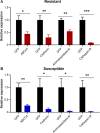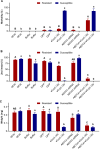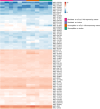Knockdown of an ATP-binding cassette transporter in resistant western corn rootworm larvae partially reverses resistance to eCry3.1Ab protein
- PMID: 39733129
- PMCID: PMC11682398
- DOI: 10.1038/s41598-024-83135-7
Knockdown of an ATP-binding cassette transporter in resistant western corn rootworm larvae partially reverses resistance to eCry3.1Ab protein
Abstract
The western corn rootworm (WCR), Diabrotica virgifera virgifera LeConte, has evolved resistance to nearly every management tactic utilized in the field. This study investigated the resistance mechanisms in a WCR strain resistant to the Bacillus thuringiensis (Bt) protein eCry3.1Ab using dsRNA to knockdown WCR midgut genes previously documented to be associated with the resistance. ATP-binding cassette transporter (ABCC4), aminopeptidase-N, cadherin, and cathepsin-B were previously found to be differentially expressed in eCry3.1Ab-resistant WCR larvae when compared to susceptible larvae after feeding on maize expressing eCry3.1Ab and its near-isoline. Here we compared the susceptibility of resistant and susceptible WCR larvae to eCry3.1Ab protein in presence or absence of dsRNA targeting the above genes using 10-day diet overlay toxicity assays. Combining ABCC4 dsRNA with eCry3.1Ab protein increased susceptibility to Bt protein in WCR-resistant larvae, but the other three genes had no such effect. Among 65 ABC transport genes identified, several were expressed differently in resistant or susceptible WCR larvae, fed on eCry3.1Ab-expressing maize versus its isoline, that may be involved in Bt resistance. Our findings provide strong evidence that ABCC4 is indirectly involved in WCR resistance to eCry3.1Ab protein by enhancing the effects of Bt-induced toxicity.
Keywords: Bacillus thuringiensis; Diabrotica virgifera virgifera; Corn rootworm; Insect resistance management; RNAi; Resistance mechanisms.
© 2024. The Author(s).
Conflict of interest statement
Competing interests: Adriano Pereira is an employee of RNAiSSANCE AG, St. Louis, MO, USA. All other authors declare no competing interests. Ethics approval and consent to participate: The experimental research and collection of plant and insect materials of this study comply with the relevant institutional, national, and international guidelines and legislation.
Figures



Similar articles
-
Differential gene expression in response to eCry3.1Ab ingestion in an unselected and eCry3.1Ab-selected western corn rootworm (Diabrotica virgifera virgifera LeConte) population.Sci Rep. 2019 Mar 20;9(1):4896. doi: 10.1038/s41598-019-41067-7. Sci Rep. 2019. PMID: 30894586 Free PMC article.
-
Detection of alternative splicing in western corn rootworm (Diabrotica virgifera virgifera LeConte) in association with eCry3.1Ab resistance using RNA-seq and PacBio Iso-Seq.Insect Mol Biol. 2021 Aug;30(4):436-445. doi: 10.1111/imb.12709. Epub 2021 May 30. Insect Mol Biol. 2021. PMID: 33955085
-
Development of resistance to eCry3.1Ab-expressing transgenic maize in a laboratory-selected population of western corn rootworm (Coleoptera: Chrysomelidae).J Econ Entomol. 2013 Dec;106(6):2506-13. doi: 10.1603/ec13148. J Econ Entomol. 2013. PMID: 24498752
-
RNAi induced knockdown of a cadherin-like protein (EF531715) does not affect toxicity of Cry34/35Ab1 or Cry3Aa to Diabrotica virgifera virgifera larvae (Coleoptera: Chrysomelidae).Insect Biochem Mol Biol. 2016 Aug;75:117-24. doi: 10.1016/j.ibmb.2016.06.006. Epub 2016 Jun 19. Insect Biochem Mol Biol. 2016. PMID: 27334721
-
Resistance to Bt maize by western corn rootworm: insights from the laboratory and the field.Curr Opin Insect Sci. 2016 Jun;15:111-5. doi: 10.1016/j.cois.2016.04.001. Epub 2016 Apr 13. Curr Opin Insect Sci. 2016. PMID: 27436740 Review.
References
-
- Wechsler, S. & Smith, D. Has resistance taken root in US corn fields? Demand for insect control. Am. J. Agr Econ.100, 1136–1150 (2018).
-
- Gray, M. E., Sappington, T. W., Miller, N. J., Moeser, J. & Bohn, M. O. Adaptation and invasiveness of western corn rootworm: intensifying research on a worsening pest. Ann. Rev. Entomol.54, 303–321 (2009). - PubMed
-
- Moellenbeck, D. J. et al. Insecticidal proteins from Bacillus thuringiensis protect corn from corn rootworms. Nat. Biotechnol.19, 668–672 (2001). - PubMed
-
- Vaughn, T. et al. A method of controlling corn rootworm feeding using a Bacillus thuringiensis protein expressed in transgenic maize. Crop Sci.45, 931–938 (2005).
Publication types
MeSH terms
Substances
Grants and funding
LinkOut - more resources
Full Text Sources
Research Materials

